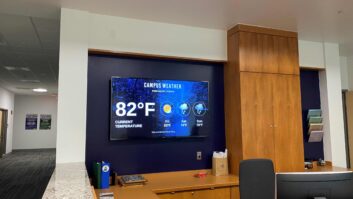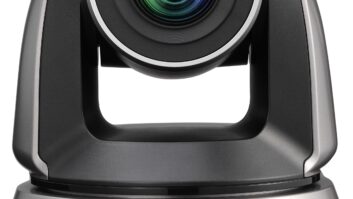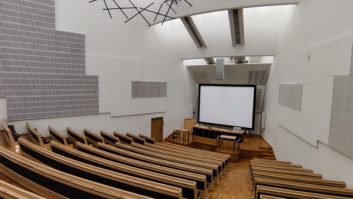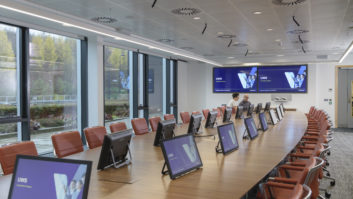What will school classrooms of the future look like? Is it possible that in the near future they might become as sophisticated as today’s corporate boardrooms? Already teachers are using inspirational technology to create motivational environments for pupils and bring new life to their work. Will this continue or might they eventually be bogged down by audiovisual aids, baffled by an array of remote controls and choices?
Last month’s British Education and Technology Training (BETT) Show at London’s Olympia attracted more than 600 exhibiting educational suppliers. The event brings together the global teaching and learning community for four days of innovations and inspirations.
It is dedicated to showcasing the best in international educational technology products, resources and best practice. This year it celebrated 25 years as the world’s leading educational information and communications technology event.
One of the central themes to emerge from BETT is the growing number of technologies available that enable pupils to present and share ideas using new-media platforms. Additionally, teachers will potentially be able to communicate on a deeper level than has previously been possible. In short, technology is helping students to move away from the dominance of an individual computer experience to a more shared learning culture.
Today, technology has to appeal to all types and abilities of learners whether they are kinesthetic (and so need to be physically engaged with the lesson), visual or audio learning types. This is where classroom tools such as interactive whiteboards (IWBs) play a crucial role.
Creating a shared learning experience is also the goal of companies such as PolyVision, which makes IWBs and the Thunder ‘virtual flipchart’ collaborative platform. Since its introduction in mid-2006, Thunder has been adopted by numerous primary and secondary educational institutions, creating opportunities for advanced collaborative learning with its ability to surround students with content and pull in material and participants from around the world.
Paul Berry, sales director at Promethean, a manufacturer and supplier of education technology, estimates that in the UK over 360,000 IWBs have been installed in schools and that within a couple of years some 40,000 will be ready for replacement.
Content on demand
High on the list of new technologies for a school’s board of governors to consider is Internet Protocol Television. IPTV refers to the delivery of digital television and other audio and video services over broadband data networks using the same basic protocols that support the internet. If a teacher wants to access premium TV programming such as The History Channel or Discovery without the hassle of recording videos or running new TV cables to classrooms, then IPTV is the answer.
Many classrooms already have broadband internet access, which means that with an IPTV network in place, educational programming can be received in the classroom via an existing network connection. The content can be displayed on a classroom computer, TV, projector or IWB and can be viewed live or on-demand.
One of the key benefits of IPTV to integrators and suppliers is the ability to cut out cable companies and provide a package of programming without incurring the massive capital expenditure associated with building their own network.
Exterity is an Edinburgh-based company formed in 2001 to deliver broadcast-quality digital video over IP networks. Colin Farquhar, Exterity’s CEO, is optimistic about the year ahead: “Education is going to be a major growth sector for IPTV in 2009. Exterity products, such as TVgateway, will become an essential part of an institution’s teaching aid portfolio. Video servers will also be a critical resource, providing video on demand and the ability to share video resources.
“On-demand teaching, moving away from broadcast time restrictions, will also become mainstream. In addition, I think the education market will embrace high-definition encoding, providing amazing imagery and sound to inspire students and maintain their concentration through their learning experience.”
The company’s core technology, iSocket, allows display appliances, such as televisions, to be connected directly to wall-mounted iSockets allowing direct and easy access to available digital media and services. Farquhar says that many universities and colleges are beginning to recognise the potential of upgrading their existing networks to a future-proofed solution using IP-based iSocket technology.
An example of the technology delivering educational content to students over the web can be found at Lewisham College in south-east London. The first application is installed within the Hospitality and Catering School where vocational culinary theory is taught in state-of-the-art kitchens during master-class demonstrations. High-quality cameras capture and film the demonstrations, and the content is then distributed over the network for quick and easy student access. Students are able to choose whether they wish to watch live, on a smartboard at the college, or even at home via the web.
“Our work with Lewisham College is a good example of how we are able to turn the traditional teaching environment into a versatile tool offering complete learning flexibility, simultaneously bringing real skills to a larger group of people in a way that suits their needs,” adds Farquhar.
Encouraging interaction
Another company that sees the same opportunity is AV integrator Reflex. It has recorded an increase in demand for IPTV technology from its well-established higher education base. The company believes the reason IPTV is gaining momentum in the education market is that instead of being a passive technology like traditional TV, it is two-way – users can interact with the content delivered to the screen, which makes it ideal for learning. Students can navigate through a series of high-quality videos and text pages, take tests and be assessed on their results.
According to Reflex’s head of projects, Steve Phippen: “IPTV is opening up new ways of delivering for universities. For example, the company has made available up to 100 channels through IPTV into University College of London’s language labs, where it is used to communicate with foreign students and to assist with their coursework.”
Digital signage in education is increasing teachers’ ability to communicate quickly and more effectively than was possible with handwritten notice boards.
ONELAN, a UK company based in Henley-on-Thames, has developed a cost-effective, stand-alone digital signage solution, called the Net-Top-Box (NTB). This is a digital signage media player box with an 80GB memory that displays communications in high definition using live TV or video feed, RSS, HTML and Flash content, all on one screen.
A built-in web server allows users to configure scheduled, zoned multimedia content for a variety of display screens. Last month saw the launch of the company’s latest product, Duet Suite, a stand-alone USB web camera that allows teachers to record and playback their lesson via a school’s server, then the web.
Commenting on the new product, ONELAN’s managing director, David Dalzell, says: “We hope that Duet Suite will become popular in academic and corporate establishments as a means of creating, storing and playing lessons, lectures, tutorials or presentations. We see it as complementing our digital signage and live TV streaming products. In academia, we see the Duet Suite fitting into a flexible learning environment where teaching material is delivered and regularly recorded, thereby helping on-campus students or absent students to keep up with their academic programmes.”
Vote now
Electronic voting systems are another good example of how technology is helping to aid learning. Qwizdom is one of the UK’s leading providers of voting systems. Using advanced radio frequency technology, the company’s handheld remotes and interactive writing tablets are designed to engage an audience in the boardroom, classroom, or for staff training. The systems are currently used in over 2,000 primary and secondary schools across the UK.
Catering for all learning styles, its full range of ergonomic handheld student response system comes complete with Actionpoint, Qwizdom’s specially devised plug-in for Microsoft PowerPoint. Compatible with both PC and Mac, the results can be displayed as charts, graphs and tables.
In 2009 the company will be promoting its new wireless tablet, Q7, which combines advanced RF technology, presenter controls, and response system interactivity to help teachers and students connect and collaborate in completely new ways.
Qwizdom’s Gary Morrison, sales and marketing director, comments on the new product: “Its sleek, modern design allows teachers to draw, annotate and control computer applications without being tethered to a computer. Additionally, presenters can view notes, presentation indicators, and input from participants on the tablet’s LCD screen.”
LCD projectors have long been established as a core visual aid for teachers. At BETT, Hitachi showcased its new ED-A101 and CPX 4 projector models, which look set to be a leap forward for low-cost, effective classroom projection. Hitachi describes the ED-A101 as the world’s first high-performance free-shaped lens. Its key selling point is its short throw distance of just 42cm (1.4ft) for a 60in projection. The dramatic reduction in throw distance and the high angle projection capability means that the 2,000 lumens projector can be positioned very close to the screen.
“Hitachi is now offering education the same low cost of ownership as is enjoyed by those consumers purchasing our latest general-purpose projectors,” says Axel Kutschke, senior manager for Hitachi’s presentation products. “By offering all the security, performance and ease of use required by education, together with the latest advances from our commercial projectors, this model offers education outstanding lifetime value and the best of both worlds.”
In the modern teaching environment large noisy classes have made keeping pupils engaged and working effectively a harder task than ever before. Sound reinforcement is increasingly becoming the norm in both schools and higher education establishments.
Teachers’ speech ‘signal’ levels drop away quickly over very short distances in noisy surroundings, and dead zones always leave some pupils out of the centre of attention.
This can result in poor comprehension, inadequate attention being paid to lessons and lower academic results. Although good acoustic design in a classroom can help make the teacher’s voice clearer, installing a sound system is increasingly seen as the single most cost-effective way of boosting a child’s comprehension in a noisy classroom.
One of the UK’s leading suppliers of sound systems to the education sector is London-based PC Werth. Founded 60 years ago by Peter Werth, a pioneer in bringing sophisticated hearing technology to the UK, the company now offers its range of Soundfield classroom amplification systems as well as body-worn systems for hearing-impaired children.
Unlimited options
Over 6,000 classrooms in the UK have benefited from Soundfield, which uses a lightweight wireless microphone to transmit a teacher’s voice to a base station. This then amplifies and enhances speech frequencies and broadcasts it from speakers.
FrontRow Pro Digital Soundfield is one of the company’s most popular digital speech enhancement systems for classrooms. Using Adapto digital technology and wireless infrared communication it can deliver speech to an unlimited number of classrooms, with no danger of interference. New for 2009 is the infrared speaker and sensor in one module, reducing installation time and visual clutter.
A key factor in any classroom’s AV set-up is how successfully the different elements are integrated. Neets is a leading Danish manufacturer of control components applications, specialising in advanced, user-friendly control systems for projectors, electric screens and other equipment for classrooms and conference rooms. Its range of control systems includes what it claims is the world’s smallest projector control – the FoXtrot, which is said to be ideal for a classroom.
Signe Vognsen de Vos, head of marketing at Neets, comments on the use of the company’s products in schools. “We make the systems small so they will fit directly into the standard outlet and blend in with the rest of the switches,” she says. “Furthermore they have an automatic power-on function, and start by pressing any key on the panel. Finally the systems are easy and intuitive to use and program.” Besides the broad range of control systems, Neets is constantly developing new accessory products such as relay boxes, USB switches, serial splitters and extenders.
Integration systems made by Crestron are also doing healthy business in the education sector. The company has been serving the market for more than three decades and understands the unique requirements of the academic community.
Gregor Rimmell, who was recently appointed education sales manager at the company, gives some of his thoughts on its position in the current market.
“We have always had a reputation for excellent support of the educational sector. With our ever-increasing range of products, the robust and practical solutions can spread further into all corners of the education market. Crestron is also in a position to alleviate some of the pressure educational audiovisual managers are under, by using RoomView room management software to monitor rooms quickly and accurately. Remote support via the XPanel technology also decreases downtime and offers practical and instantaneous support for academics.”
Room for growth
The British Educational Communications and Technology Agency’s (Becta) Harnessing Technology Review 2008 presented a mixed picture of the adoption, use and impact of technology in education.
It claims that there have been many promising areas of progress in the past year, with a significant increase in the use of learning platforms and improved integration with management information systems. However, the use of learning platforms is still at an early stage in schools and the report raises concerns about the pockets of very limited adoption.
In particular, there appears to be a stubborn core of ‘late adopter’ further education colleges and a long tail of primary schools with limited provision and use of IT.
Phil Bannister from Becta’s evidence and evaluation directorate urges a note of caution, however. “Nobody’s quite sure about the long-term effects of using whiteboards with pupils and if they’re going to get bored with seeing yet another lesson presented in this way. We don’t know that the motivational effects of the technology are going to last forever.” IE






